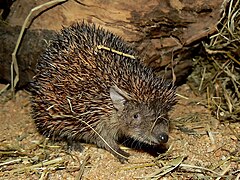Tenreki – Wikipedia, wolna encyklopedia
| Tenrecinae | |||||
| J.E. Gray, 1821[1] | |||||
 Przedstawiciel rodzaju – tenreczynek jeżowaty (Echinops telfairi) | |||||
| Systematyka | |||||
| Domena | |||||
|---|---|---|---|---|---|
| Królestwo | |||||
| Typ | |||||
| Podtyp | |||||
| Gromada | |||||
| Podgromada | |||||
| Infragromada | |||||
| Rząd | |||||
| Podrząd | |||||
| Rodzina | |||||
| Podrodzina | tenreki | ||||
| Typ nomenklatoryczny | |||||
| Tenrec Lacépède, 1799 | |||||
| |||||
| Rodzaje | |||||
| |||||
Tenreki[16] (Tenrecinae) – podrodzina ssaków z rodziny tenrekowatych (Tenrecidae).
Występowanie
[edytuj | edytuj kod]Podrodzina obejmuje gatunki występujące na Madagaskarze[17][18].
Podział systematyczny
[edytuj | edytuj kod]Do podrodziny należą następujące rodzaje[19][17][16]:
- Echinops Martin, 1838 – tenreczynek – jedynym przedstawicielem jest Echinops telfairi Martin, 1838 – tenreczynek jeżowaty
- Setifer Froriep, 1806 – jeżokret – jedynym przedstawicielem jest Setifer setosus (Schreber, 1778) – jeżokret kłujący
- Tenrec Lacépède, 1799 – tenrek – jedynym przedstawicielem jest Tenrec ecaudatus (Schreber, 1778) – tenrek zwyczajny
- Hemicentetes Mivart, 1871 – tenrekowiec
Uwagi
[edytuj | edytuj kod]- ↑ Typ nomenklatoryczny: Centetes Illiger, 1811 (= Tenrec Lacépède, 1799).
- ↑ Typ nomenklatoryczny: Echinogale Wagner, 1841 (= Echinops Martin, 1838).
- ↑ Typ nomenklatoryczny: Ericulus I. Geoffroy Saint-Hilaire, 1837 (= Setifer Froriep, 1806).
Przypisy
[edytuj | edytuj kod]- ↑ J.E. Gray. On the Natural Arrangment of Vertebrose Animals. „The London Medical Repository”. 15, s. 301, 1821. (ang.).
- ↑ J.E. Gray. An Outline of an Attempt at the Disposition of Mammalia into Tribes and Families, with a List of the Genera apparently appertaining to each Tribe. „Annals of Philosophy”. New Series. 10, s. 339, 1825. (ang.).
- ↑ Ch.-L. Bonaparte. Synopsis Vertebratorum Systematis. „Nuovi annali delle scienze naturali”. 2, s. 113, 1838. (łac.).
- ↑ W.C.H. Peters. Über die Säugethiergattung Solenodon. „Abhandlungen der Königlichen Akademie der Wissenschaften zu Berlin”. Aus dem Jahre 1864, s. 21, 1864. (niem.).
- ↑ E. Haeckel: Generelle morphologie der organismen. Allgemeine grundzüge der organischen formen-wissenschaft, mechanisch begründet durch die von Charles Darwin reformirte descendenztheorie. Cz. 2. Berlin: G. Reimer, 1866, s. clx. (niem.).
- ↑ Murray 1866 ↓, s. xiv, 344.
- ↑ a b Murray 1866 ↓, s. 319.
- ↑ T.N. Gill. Arrangement of the Families of Mammals; with Analytical Tables. „Smithsonian Miscellaneous collections”. 11, s. 19, 1872. (ang.).
- ↑ Trouessart 1879 ↓, s. 272.
- ↑ Trouessart 1879 ↓, s. 273.
- ↑ Winge 1917 ↓, s. 155.
- ↑ Winge 1917 ↓, s. 156.
- ↑ A. Cabrera: Genera mammalium. Insectivora, Galeopithecia. Madrid: Museo Nacional de Ciencias Naturales, 1925, s. 183, 191. (hiszp.).
- ↑ G.G. Simpson. A new classification of mammals. „Bulletin of the American Museum of Natural History”. 59 (5), s. 268, 1931. (ang.).
- ↑ S.B. McDowell Jr.. The Greater Antillean insectivores. „Bulletin of the American Museum of Natural History”. 115 (3), s. 202, 210, 1958. (ang.).
- ↑ a b Nazwy polskie za: W. Cichocki, A. Ważna, J. Cichocki, E. Rajska-Jurgiel, A. Jasiński & W. Bogdanowicz: Polskie nazewnictwo ssaków świata. Warszawa: Muzeum i Instytut Zoologii PAN, 2015, s. 19–20. ISBN 978-83-88147-15-9. (pol. • ang.).
- ↑ a b C.J. Burgin, D.E. Wilson, R.A. Mittermeier, A.B. Rylands, T.E. Lacher & W. Sechrest: Illustrated Checklist of the Mammals of the World. Cz. 1: Monotremata to Rodentia. Barcelona: Lynx Edicions, 2020, s. 106–107. ISBN 978-84-16728-34-3. (ang.).
- ↑ D.E. Wilson & D.M. Reeder (redaktorzy): Subfamily Tenrecinae. [w:] Mammal Species of the World. A Taxonomic and Geographic Reference (Wyd. 3) [on-line]. Johns Hopkins University Press, 2005. [dostęp 2020-10-28].
- ↑ N. Upham, C. Burgin, J. Widness, M. Becker, C. Parker, S. Liphardt, I. Rochon & D. Huckaby: Treeview of Mammalian Taxonomy Hierarchy. [w:] ASM Mammal Diversity Database (Version 1.11) [on-line]. American Society of Mammalogists. [dostęp 2023-08-14]. (ang.).
Bibliografia
[edytuj | edytuj kod]- A. Murray: The Geographical Distribution of Mammals. London: Day and Son, 1866, s. i–xvi, 1–420. (ang.).
- É.L. Trouessart. Synopsis sytematicus et geographicus mammalium. „Revue et magasin de zoologie pure et appliquée”. 3e série. 7, s. 224–285, 1879. (fr.).
- H. Winge. Udsigt over Insektædernes indbyrdes Slægtskab. „Videnskabelige Meddelelser fra Dansk naturhistorisk Forening i Kjøbenhavn”. 68, s. 83–203, 1917. (szw.).


 French
French Deutsch
Deutsch